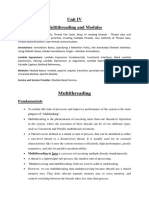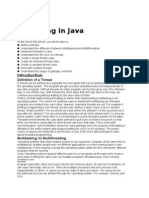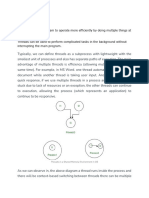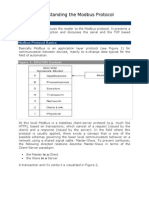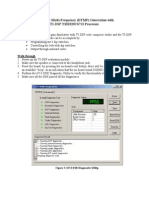Top 20 Java Multithreading Interview Questions &
Uploaded by
Siddiqui JamalTop 20 Java Multithreading Interview Questions &
Uploaded by
Siddiqui JamalGEEKSFORGEEKS
Top 20 Java Multithreading
Interview Questions & Answers
Java has been rated number one in TIOBE popular
programming developers which are used by over 10
Million developers over 15 billion devices supporting
Java. It is used for creating applications for trending
technologies like Big Data to household devices like
Mobiles and DTH Boxes, it is used everywhere in
today’s information age.
Multithreading in Core Java(J2SE) is a very important
topic from an interview point of view. It can lead you
to become a Java Developer, Java Testing
Engineer, Java Architect, Lead Analyst, Java
Consultant, and most important a real good Java
programmer enabling the confidence to dive in J2EE
programming which stands for Java to enterprising
edition or in layman language making you fit to work
in corporate domain workflow directly. Perks wide
varied in India for Java developers from 300K to
25000K for as fresher based upon the level of
intellect.
So, let’s get started with most asked Java
Multithreading Interview Questions with their detailed
answers.
Q-1 What is multitasking?
A multitasking operating system is an operating
system that gives you the perception of 2 or more
tasks/jobs/processes running at the same time. It
does this by dividing system resources amongst
these tasks/jobs/processes and switching between
the tasks/jobs/processes while they are executing
over and over again. Usually, the CPU processes
only one task at a time but the switching is so fast
that it looks like the CPU is executing multiple
processes at a time. They can support either
preemptive multitasking, where the OS provides time
to applications (virtually all modern OS), or
cooperative multitasking, where the OS waits for the
program to give back control (Windows 3.x, Mac OS
9, and earlier), leading to hangs and crashes. Also
known as Timesharing, multitasking is a logical
extension of multiprogramming.
Multitasking programming is of two types which are
as follows:
1. Process-based Multitasking
2. Thread-based Multitasking
Note: Performing multiple tasks at one time is
referred to as multithreading in java which is of
two types namely Process-based multithreading
and Thread based multithreading.
Q-2 How can you identify the process?
Any program which is in a working state is referred to
as a process. These processes do have threads that
are single dispatchable units.
Q-3 How do you see a thread?
In order to see threads status let us take windows as
an operating system, it illustrates then we’d have
ProcessExplorer where you can see GUI shown
below for windows operating systems.
This PC > OS > Users > GeeksforGeeks > Downloads >
ProcessExplorer is illustrated below in the windows
operating systems
Note: All of them as listed in the above media
are the processes as shown above where at a
time many are running in parallel to each other
henceforth illustrating multiprocessing in the
Jwindows operating system.
As we have seen threads do reside in a single
process so we have to deep dive into a specific
process to see them in order to show users how
multithreading is going on in the computers at the
backend. For example: let us pick a random process
from the above media consisting of various processes
say it be ‘chrome’. Now we need to right-click over
the process and click the properties’ menu.
From the above media, it is clearly perceived that
chrome is a process and after proceeding with the
steps to figure out threads running inside the chrome
process we go to properties of the process ‘chrome’
below pictorial output will be generated representing
threads running in the process chrome.
Note: If we look scroll way from up to down then
it will be seeing some colors against a few of
those threads. Here green color threads are
associated as the newly created threads and red
colors associated threads are representing the
closed threads.
Note: So for chrome to increase the
performance by reducing the response time that
is referred to as Thread based multitasking.
Q-4 What is Multithreading and How it is Different
from Multitasking?
Multithreading is a specialized form of multitasking.
Process-based multitasking refers to executing
several tasks simultaneously where each task is a
separate independent process is Process-based
multitasking.
Example: Running Java IDE and running TextEdit at
the same time. Process-based multitasking is
represented by the below pictorial which is as follows:
Thread-based multitasking refers to executing
several tasks simultaneously where each task is a
separate independent part of the same program
known as a thread. For example, JUnits uses
threads to run test cases in parallel. Henceforth,
process-based multitasking is a bigger scenario
handling process where threads handle the details. It
is already discussed to deeper depth already with
visual aids.
For more details, please refer to Process-based
and Thread-based multitasking in Java
Q-5 Which Kind of Multitasking is Better and
Why?
Thread-based multitasking is better as multitasking of
threads requires less overhead as compared to
process multitasking because processes are
heavyweight in turn requiring their own separate
address space in memory while threads being very
light-weight processes and share the same address
space as cooperatively shared by heavyweight
processes.
Switching is a secondary reason as inter-process
communication is expensive and limited. Context
switching from one process to another is cost hefty
whereas inter-thread communication is inexpensive
and context switching from one thread to another is
lower in cost.
Note: However java programs make use of
process-based multitasking environments, but
this feature is not directly under Java’s direct
control while multithreading is complete.
Q-6 What is a thread?
Threads are lightweight processes within processes
as seen. In java, there are two ways of creating
threads namely via Thread class and via Runnable
interface.
To read more about this, please refer Thread class in
Java, Runnable interface in Java
Q-7 What are the different states of a thread, or
what is thread lifecycle?
A thread in Java at any point of time exists in any one
of the following states. A thread lies only in one of the
shown states at any instant:
1. New
2. Runnable
3. Blocked
4. Waiting
5. Timed Waiting
6. Terminated
To read more about this, please refer Lifecycle and
States of a Thread in Java
Q-8 What is the task of the main thread?
All Java programs have at least one thread, known as
the main thread which is created by JVM at the
program start when the main() method is invoked with
the main thread as depicted from the output
perceived from pseudo-code illustration.
Illustration:
System.out.println(“Mayank Solanki”);
Output: Mayank Solanki
System.out.println(Thread.currentthread().getname()
Output: main
Q-9 What are the Different Types of threads in
Java?
There are two types of threads in Java as follows:
User thread
Daemon thread
User threads are created by java developers for
example Main thread. All threads are created inside
the main() method are by default non-daemon thread
because the ‘main’ thread is non-daemon. Daemon
thread is a low-priority thread that runs in the
background to perform tasks such as garbage
collection, etc. They do not prevent daemon threads
from exiting when all user threads finish their
execution. JVM terminates itself when all non-
daemon threads finish their execution. JVM does not
care whether a thread is running or not, if JVM finds a
running daemon thread it terminates the thread and
after that shutdown itself.
Q-10 How to Create a User thread?
As discussed earlier when the JVM starts it creates a
main thread over which the program is run unless an
additional thread is not created by the user. The first
thing “Main” thread looks for ‘public static void
main(String [] args)’ method to invoke it as it acts as
an entry point to the program. All other threads
created in main acts as child threads of the “Main”
thread.
User thread can be implemented in two ways listed
below:
1. Using Thread class by extending java.lang.Thread
class.
2. Using Runnable Interface by implementing it.
Q-11 How to set the name of the thread?
We can name a thread by using a method been
already up there known as setName() replacing
default naming which was ‘Thread-0’, ‘Thread-1’, and
so on.
thread_class_object.setName("Name_thread_here");
Q-12 What is thread priority?
Priorities in threads is a concept where each thread
is having a priority which in layman’s language one
can say every object is having priority here which is
represented by numbers ranging from 1 to 10.
The default priority is set to 5 as excepted.
Minimum priority is set to 0.
Maximum priority is set to 10.
Here 3 constants are defined in it namely as follows:
1. public static int NORM_PRIORITY
2. public static int MIN_PRIORITY
3. public static int MAX_PRIORITY
To read more about this, please refer Thread Priority
in Multithreading in Java
Q-13 How deadlock plays a important role in
multithreading?
If we do incorporate threads in operating systems one
can perceive that the process scheduling algorithms
in operating systems are strongly deep-down working
on the same concept incorporating thread in Gantt
charts. A few of the most popular are listed below
which wraps up all of them and are used practically in
software development.
First In First Out
Last In First Out
Round Robin Scheduling
Now one Imagine the concept of Deadlock in
operating systems with threads by now how the
switching is getting computed over internally if one
only has an overview of them.
Q-14 Why output is not ordered?
Scheduling of threads involves two boundary
scheduling,
Scheduling of user-level threads (ULT) to kernel-
level threads (KLT) via lightweight process (LWP)
by the application developer.
Scheduling of kernel-level threads by the system
scheduler to perform different unique os functions.
If multiple threads are waiting to execute then thread
execution is decided by “ThreadScheduler” which is a
part of JVM hence its vendor dependent resulting in
unexpected execution of output order.
Note:
In multithreading, the guarantee of order is
very less where we can predict possible
outputs but not exactly one.
Also, note that synchronization when
incorporated with multithreading does affect
our desired output simply by using the
keyword ‘synchronized’.
It is as illustrated in the below illustration which is as
follows:
Q-15 What is Daemon Thread in Java and explain
their properties?
Daemon thread is a low-priority thread that runs in the
background to perform tasks such as garbage
collection. It does possess certain specific properties
as listed below:
They can not prevent the JVM from exiting when all
the user threads finish their execution.
JVM terminates itself when all user threads finish
their execution
If JVM finds a running daemon thread, it terminates
the thread and after that shutdown itself. JVM does
not care whether the Daemon thread is running or
not.
It is an utmost low priority thread
Note: The main difference between user thread
and daemon thread is that JVM does not wait for
daemon thread before exiting while it do waits
for the user thread.
To read more about this, please refer to Daemon
Thread in Java
Q-16 How to Make User Thread to Daemon
Thread?
It is carried out with the help of two methods listed in
‘Thread class’ known as setDaemon() and
isDaemon(). First, the setDaemon() method converts
user thread to daemon thread and vice-versa. This
method can only be called before starting the thread
using start() method else is called after starting the
thread with will throw IllegalThreadStateException
After this, isDaemon() method is used which returns a
boolean true if the thread is daemon else returns
false if it is a non-daemon thread.
Q-17 What are the tasks of the start() method?
The primary task of the start() method is to register
the thread with the thread scheduler, so one can tell
what child thread should perform, when, and how it
will be scheduled that is handled by the thread
scheduler. The secondary task is to call the
corresponding run() method got the threads.
Q-18 What is the difference between the start()
and run() method?
First, both methods are operated in general over the
thread. So if we do use threadT1.start() then this
method will look for the run() method to create a new
thread. While in case of theadT1.run() method will be
executed just likely the normal method by the “Main”
thread without the creation of any new thread.
Note: If we do replace start() method with run()
method then the entire program is carried by
‘main’ thread.
Q-19 Can we Overload run() method? What if we
do not override the run() method?
Yes, it is possible to overload run() by passing
parameters to it and also keeping a check over to
comment down @override from the run() method.
It should be as good as a thread wherein thread we
do not have any arguments, so practice to overload is
to comment on the call out for overloaded run()
method. Now, so we need to acknowledge the same
whether the output is the same or not if we have not
overloaded it.
If we have overloaded the run() method, then we will
observe that output is always the main method as can
be perceived from the stack call from the above
image. It is because if we debug the code as provided
in the link below we see as soon as the start() method
is called again, run() is called because we have not
overridden the run() method.
For more refer to the Implementation part of how the
run() method is overloaded
Conclusion: We can overload the run() method
but start() method will call no argument run()
only. Hence, it will be of no help to us and is
considered as bad practice.
The compiler will simply execute the run() method of
the Thread class, keeping a check that the run()
method of the Thread class must have an empty
implementation. Hence, it results out in no output
corresponding to the thread. As we have discussed
above already, if we try to do so, then the Thread
class run() method will be called and we will never get
our desired output.
Note: Geek initially we are requesting to create a
thread for us and later the same thread is doing
nothing for us which we have created. So it
becomes completely meaningless to us by
writing unwanted operations to our code
fragments. Hence, it becomes useless not to
override the run() method.
Q-20 Can we Override the start() method?
Even if we override the start() method in the custom
class then no initializations will be carried on by the
Thread class for us. The run() method is also not
called and even a new thread is also not created.
Note: We can not restart the same thread again
as we will get IllegalThreadStateException from
java.lang package. Alongside we can not do this
indirectly with usage of ‘super.start()’ method.
Article Tags : Java Java-Multithreading
Recommended Articles
1. Top 25 Android Interview Questions and Answers For
Experienced
2. Java Multithreading Program with Example
3. Java Multithreading - One Thread to Take Input,
Another to Print on Console
4. Multithreading in Java
5. What does start() function do in multithreading in Java?
6. Java Thread Priority in Multithreading
7. Deadlock in Java Multithreading
8. Java Collections Interview Questions and Answers
9. Java Interview Questions and Answers
10. MultiThreading in Android with Examples
11. Limitations of synchronization and the uses of static
synchronization in multithreading
12. 30 OOPs Interview Questions and Answers (2024)
13. Spring MVC Interview Questions and Answers
14. Difference Between java.sql.Time, java.sql.Timestamp
and java.sql.Date in Java
15. Commonly Asked Java Programming Interview
Questions | Set 1
16. Core Java Interview Questions For Freshers
17. Commonly Asked Java Programming Interview
Questions | Set 2
18. Top 7 Reasons To Migrate From Java 8 to Java 17
19. Java Tricky Output Questions
20. 10 Most asked Questions from Java Programmers
21. Frequently asked questions for Java Developer
Position from a fresher
22. How to Convert java.sql.Date to java.util.Date in Java?
23. Different Ways to Convert java.util.Date to
java.time.LocalDate in Java
24. How to Convert java.util.Date to java.sql.Date in Java?
25. Java AWT vs Java Swing vs Java FX
Read Full Article
A-143, 9th Floor, Sovereign Corporate
Tower, Sector-136, Noida, Uttar Pradesh -
201305
Company
About Us
Legal
Careers
In Media
Contact Us
Advertise with us
GFG Corporate Solution
Placement Training Program
Explore
Job-A-Thon Hiring Challenge
Hack-A-Thon
GfG Weekly Contest
Offline Classes (Delhi/NCR)
DSA in JAVA/C++
Master System Design
Master CP
GeeksforGeeks Videos
Geeks Community
Languages
Python
Java
C++
PHP
GoLang
SQL
R Language
Android Tutorial
DSA
Data Structures
Algorithms
DSA for Beginners
Basic DSA Problems
DSA Roadmap
DSA Interview Questions
Competitive Programming
Data Science & ML
Data Science With Python
Data Science For Beginner
Machine Learning Tutorial
ML Maths
Data Visualisation Tutorial
Pandas Tutorial
NumPy Tutorial
NLP Tutorial
Deep Learning Tutorial
Web Technologies
HTML
CSS
JavaScript
TypeScript
ReactJS
NextJS
NodeJs
Bootstrap
Tailwind CSS
Python Tutorial
Python Programming Examples
Django Tutorial
Python Projects
Python Tkinter
Web Scraping
OpenCV Tutorial
Python Interview Question
Computer Science
GATE CS Notes
Operating Systems
Computer Network
Database Management System
Software Engineering
Digital Logic Design
Engineering Maths
DevOps
Git
AWS
Docker
Kubernetes
Azure
GCP
DevOps Roadmap
System Design
High Level Design
Low Level Design
UML Diagrams
Interview Guide
Design Patterns
OOAD
System Design Bootcamp
Interview Questions
School Subjects
Mathematics
Physics
Chemistry
Biology
Social Science
English Grammar
Commerce
Accountancy
Business Studies
Economics
Management
HR Management
Finance
Income Tax
UPSC Study Material
Polity Notes
Geography Notes
History Notes
Science and Technology Notes
Economy Notes
Ethics Notes
Previous Year Papers
Preparation Corner
Company-Wise Recruitment Process
Resume Templates
Aptitude Preparation
Puzzles
Company-Wise Preparation
Companies
Colleges
Competitive Exams
JEE Advanced
UGC NET
SSC CGL
SBI PO
SBI Clerk
IBPS PO
IBPS Clerk
More Tutorials
Software Development
Software Testing
Product Management
Project Management
Linux
Excel
All Cheat Sheets
Free Online Tools
Typing Test
Image Editor
Code Formatters
Code Converters
Currency Converter
Random Number Generator
Random Password Generator
Write & Earn
Write an Article
Improve an Article
Pick Topics to Write
Share your Experiences
Internships
@GeeksforGeeks, Sanchhaya Education Private Limited, All
rights reserved Open In App
You might also like
- EDU 220 81 B Mod04 HighAvailability 636736803262265056No ratings yetEDU 220 81 B Mod04 HighAvailability 63673680326226505617 pages
- Multithreading Concept: by The End of This Chapter, You Will Be Able To100% (1)Multithreading Concept: by The End of This Chapter, You Will Be Able To78 pages
- For Editing-B3-Unit_1 Multithraded ProgrammingEditedNo ratings yetFor Editing-B3-Unit_1 Multithraded ProgrammingEdited28 pages
- IT Unit 6 - Multi Threaded Programming and Exception Handling-1No ratings yetIT Unit 6 - Multi Threaded Programming and Exception Handling-183 pages
- Multithreading in Java With Examples: Multitasking Vs Multithreading Vs Multiprocessing Vs Parallel ProcessingNo ratings yetMultithreading in Java With Examples: Multitasking Vs Multithreading Vs Multiprocessing Vs Parallel Processing3 pages
- Advanced Java Programing Individual AssignmentNo ratings yetAdvanced Java Programing Individual Assignment17 pages
- Multithreaded Programming: ConcurrentlyNo ratings yetMultithreaded Programming: Concurrently16 pages
- Java Programming Chapter 5 Multithreading DetailNo ratings yetJava Programming Chapter 5 Multithreading Detail19 pages
- slidesgo-navigating-the-digital-landscape-understanding-internet-protocols-and-their-role-in-modern-applicat-20241213131231QmHWNo ratings yetslidesgo-navigating-the-digital-landscape-understanding-internet-protocols-and-their-role-in-modern-applicat-20241213131231QmHW12 pages
- Hitachi Virtual Storage Platform 5000 Series Enterprise StorageNo ratings yetHitachi Virtual Storage Platform 5000 Series Enterprise Storage2 pages
- Computer Networks & Data Communication: S. J. Jereesha SebastinNo ratings yetComputer Networks & Data Communication: S. J. Jereesha Sebastin21 pages
- Hands-On Tutorial With Openthread: Key PointsNo ratings yetHands-On Tutorial With Openthread: Key Points33 pages
- Design Issues of Microsoft Teams: in Terms of AffordanceNo ratings yetDesign Issues of Microsoft Teams: in Terms of Affordance13 pages



